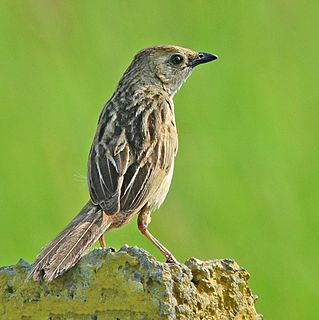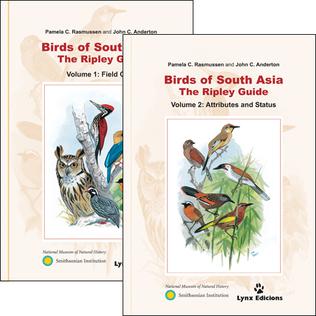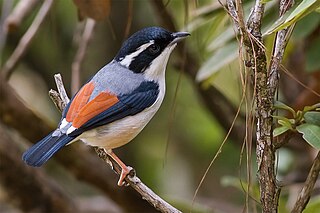Related Research Articles

The common cuckoo is a member of the cuckoo order of birds, Cuculiformes, which includes the roadrunners, the anis and the coucals.

The brown shrike is a bird in the shrike family that is found mainly in Asia. It is closely related to the red-backed shrike and isabelline shrike. The genus name, Lanius, is derived from the Latin word for "butcher", and some shrikes are also known as "butcher birds" because of their feeding habits. The specific cristatus is Latin for "crested", used in a broader sense than in English. The common English name "shrike" is from Old English scríc, "shriek", referring to the shrill call.

The puff-throated babbler or spotted babbler is a species of passerine bird found in Asia. They are found in scrub and moist forest mainly in hilly regions. They forage in small groups on the forest floor, turning around leaf litter to find their prey and usually staying low in the undergrowth where they can be hard to spot. However, they have loud and distinct calls, including a morning song, contact and alarm calls. It is the type species of the genus Pellorneum which may, however, currently include multiple lineages.

The tawny-bellied babbler also known in older Indian works as the rufous-bellied babbler is a small babbler that forages in small groups in low scrub forests. Like other members of the large Old World babbler family they are passerine birds characterised by soft fluffy plumage. There are three subspecies within the Indian Subcontinent. The nominate hyperythra found in northern and eastern India is uniformly brown underneath while albogularis of the western Indian peninsula is white throated. The population in Sri Lanka, phillipsi, is also white throated but is paler underneath and has a larger bill.

The dark-fronted babbler is an Old World babbler found in the Western Ghats of India and the forests of Sri Lanka. They are small chestnut brown birds with a dark black cap, a whitish underside and pale yellow iris. They forage in flocks in the undergrowth of forests constantly making calls and uttering alarm calls when disturbed.

Biswamoy Biswas was an Indian ornithologist who was born in Calcutta, the son of a professor of geology. In 1947, he was awarded a three-year fellowship by Sunderlal Hora, then director of the Zoological Survey of India (ZSI). It enabled him to study at the British Museum, at the Berlin Zoological Museum under Erwin Stresemann and also at the American Museum of Natural History under Ernst Mayr.

Namdapha National Park is a 1,985 km2 (766 sq mi) large protected area in Arunachal Pradesh of Northeast India. With more than 1,000 floral and about 1,400 faunal species, it is a biodiversity hotspot in the Eastern Himalayas. The national park harbours the northernmost lowland evergreen rainforests in the world at 27°N latitude. It also harbours extensive dipterocarp forests, comprising the northwestern parts of the Mizoram-Manipur-Kachin rain forests ecoregion.

The bristled grassbird is a small passerine bird in the genus Schoenicola. Also known as the bristled grass warbler, this species is endemic to the Indian subcontinent, where it is patchily distributed in Bangladesh, India, Nepal and Pakistan. These insectivorous birds skulk in dense and tall grasslands, often in marshy areas, habitats that are threatened by human activities. Formerly considered to be sedentary, the species may be migratory, moving south and east in the Indian peninsula during winter and returning to their breeding grounds in the northern plains south of the Himalayas.

The green shrike-babbler is a bird species that was earlier placed in the family Timaliidae. The species is now considered to be an Asian offshoot of the American vireos and belongs in the family Vireonidae.

Birds of South Asia: The Ripley Guide by Pamela C. Rasmussen and John C. Anderton is a two-volume ornithological handbook, covering the birds of South Asia, published in 2005 by the Smithsonian Institution and Lynx Edicions. The geographical scope of the book covers India, Bangladesh, Pakistan, Sri Lanka, Nepal, Bhutan, Maldives, the Chagos Archipelago and Afghanistan. In total, 1508 species are covered. Two notable aspects of Birds of South Asia are its distribution evidence-base — the book's authors based their distributional information almost completely on museum specimens — and its taxonomic approach, involving a large number of species-level splits.

The Sita Mata Wildlife Sanctuary is a wildlife sanctuary situated in Pratapgarh and Chittaurgarh districts of Rajasthan Rajasthan, India, declared as a protected forest area by the Government of Rajasthan Notification No. F 11 (9) Revenue/8/79, dated 2/11/1979. It is a dense forest, with an area of 422.95 square kilometers, which is about 40% of the total land area of the district. The land is undulating because of the confluence of three different formations — Malwa Plateau, the Vindhyachal Hills and Aravali mountain ranges.

The Himalayan shrike-babbler is a bird species found in the western Himalayas that belongs to the shrike-babbler group. The genus was once considered to be an aberrant Old World babbler and placed in the family Timaliidae until molecular phylogenetic studies showed them to be closely related to the vireos of the New World, leading to their addition in the family Vireonidae. Males and females have distinctive plumages, with the males being all black about with a cinnamon-rufous tertial patch and a distinctive white stripe running from behind the eye. The underside is whitish with some pinkish buff on the flanks. Females have a greyish head, lack the white stripe and have the upperparts and wings with greens, yellow and chestnut. The species is part of a cryptic species complex that was earlier considered as one species, white-browed shrike-babbler with several subspecies.
Indian Birds is a bi-monthly ornithology journal/newsletter that was established in 2004. It was formerly published under the heading Newsletter for Ornithologists for one year. It publishes articles on identification, distribution, migration, conservation and taxonomy, apart from reports of significant ornithological sightings and events. Published from Hyderabad, the publication is owned by New Ornis Foundation. In 2006, the Bugun liocichla, a new bird species from Arunachal Pradesh was described by Ramana Athreya in this journal. The description of the bird carried in the journal was made without the collection of a type specimen as they were too few to risk killing one. Though this practice was not unprecedented, with four prior instances, the pure charisma of the bird together with this practice created a controversy in the scientific and conservation community on the costs and benefits of this approach
References
- 1 2 Ali, S & SD Ripley (1999). Handbook of the Birds of India and Pakistan. Edition 2. Vol. 10. Oxford University Press.
- ↑ Ali, S. & Ripley, S.D (1980). Handbook of the Birds of India and Pakistan (Vol1). Delhi: Oxford University Press. pp. vii–xi.
{{cite book}}: CS1 maint: multiple names: authors list (link) - ↑ Ali, S. & Ripley, S.D (1980). Handbook of the Birds of India and Pakistan (Vol 2). Delhi. pp. v–ix.
{{cite book}}: CS1 maint: multiple names: authors list (link) - ↑ Ali, S. & Ripley, S.D. (1981). Handbook of the Birds of India and Pakistan (Vol 3). Delhi: Oxford University Press. pp. v–ix.
{{cite book}}: CS1 maint: multiple names: authors list (link) - ↑ Ali, S. & Ripley, S.D. (1983). Handbook of the Birds of India and Pakistan (Vol 4). Delhi: Oxford University Press. pp. v–ix.
{{cite book}}: CS1 maint: multiple names: authors list (link) - ↑ Ali, S. & Ripley, S.D. (1987). Handbook of the Birds of India and Pakistan. Delhi: Oxford University Press. pp. v–viii.
{{cite book}}: CS1 maint: multiple names: authors list (link) - ↑ Ali, S. & Ripley, S.D. (1996). Handbook of the Birds of India and Pakistan (Vol 6). Delhi: Oxford University Press. pp. v–ix.
{{cite book}}: CS1 maint: multiple names: authors list (link) - ↑ Ali, S. & Ripley, S.D. (1996). Handbook of the Birds of India and Pakistan. Delhi: Oxford University Press. pp. v–viii. ISBN 0 19 563590 6.
{{cite book}}: CS1 maint: multiple names: authors list (link) - ↑ Ali, S. & Ripley, S.D. (1997). Handbook of the Birds of India and Pakistan. Delhi: Oxford University Press. pp. v–viii. ISBN 0 19 563657 0.
{{cite book}}: CS1 maint: multiple names: authors list (link) - ↑ Ali, S. & Ripley, S.D. (1998). Handbook of the Birds of India and Pakistan. Delhi: Oxford University Press. pp. v–ix. ISBN 0 19 563695 3.
{{cite book}}: CS1 maint: multiple names: authors list (link) - ↑ Ali, S. & Ripley, S.D. (1999). Handbook of the Birds of India and Pakistan. Delhi: OUP. pp. ix–xiii.
{{cite book}}: CS1 maint: multiple names: authors list (link)